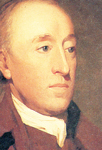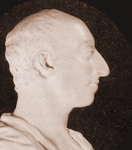“He was upright, candid, and sincere: strongly attached to his friends; ready to sacrifice anything to assist them; humane and charitable”
Hutton had a wide circle of friends reflecting his wide interests, and tt is apparent from John Playfair’s descriptions that he was popular; vivacious, quick-witted and slightly eccentric coupled with acute powers of observation, reasoning and argument. He was also widely read and knowledgeable, with a singular independence of mind.
“To his friends his conversation was inestimable; as great talents the most perfect candour, and the utmost simplicity of character and manners….This simplicity pervaded his whole conduct; while his manner, which was peculiar displayed a degree of vivacity, hardly ever to be found among men of profound and abstract speculation. His great liveliness, added to this aptness to lose sight of himself, would sometimes lead him into little eccentricities…”
“His conversation was extremely animated and forcible, and whether serious or gay, full of ingenious and original observation…Great information and an excellent memory, supplied an inexhaustible fund of illustration, always happily introduced… and in which the witty and ludicrous never failed to occupy a considerable place”.
“…a mind not fettered by prejudice nor swayed by authority”
“A mind of such singular activity and of such ardour in the pursuit of knowledge”
He was known for his bawdiness and his brevity “I ain’t like in haste to wax to fat nor fart nor fling neither”, of his description of life farming in Berwickshire, referring no doubt to the hard work he endured.
“The volcano was not created to scare superstitious minds and plunge them into fits of piety and devotion. They should be considered as the vent of a furnace” – this at a later stage in his life in defence of the formation of igneous rocks from hot liquid magma (from beneath the earth’s crust).
In Quakerish Raiment?

 What did James Hutton look like? Robert Louis Stevenson describes him from Henry Raeburn’s portrait as; ‘Hutton the geologist in quakerish raiment, looking altogether trim and narrow, as if he cared more about fossils than young ladies’. John Playfair’s opinion of Raeburn’s portrait is that it
What did James Hutton look like? Robert Louis Stevenson describes him from Henry Raeburn’s portrait as; ‘Hutton the geologist in quakerish raiment, looking altogether trim and narrow, as if he cared more about fossils than young ladies’. John Playfair’s opinion of Raeburn’s portrait is that it
“conveys a good idea of a physiognomy and character to which it was difficult to do complete justice”
His description of Hutton further suggests that the portrait conveys a reasonable likeness;
“His figure was slender, but indicated activity; while thin in countenance, a high forehead and a nose somewhat aquiline…His eye was penetrating and keen, but full of gentleness and benignity; and … his dress, plain and all of one colour."
We know from his letters that James Hutton was rather keen on young ladies and also liked brandy toddy! John Playfair also says,
“It was always true of Dr Hutton, that to an ordinary man he appeared to be an ordinary man, possessing a little more spirit and liveliness, perhaps than is usual to meet with”.